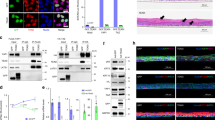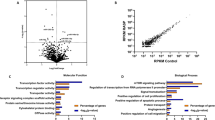Abstract
We investigated the effect of all-trans-retinoic acid (atRA) on proliferation in several human skin cell lines and found that antiproliferative potency of atRA correlated with the endogenous activity of canonical Wnt signaling. In HaCaT keratinocytes, we found that atRA significantly suppressed the expression of Id2, a member of the inhibitor of differentiation family of transcription factors that regulate cell growth and differentiation. However, no apparent change in the expression of other Wnt targets, like c-Myc or cyclin D1, was observed. Retinoid-induced Id2 gene suppression was associated with decreased levels of histone H3 and H4 acetylation and histone H3 Lys-4 methylation, and with recruitment of the LSD1 demethylase at the Wnt-response element (WRE) (TCF/LEF-binding site), in the Id2 gene promoter. None of such changes was detected at the WRE of c-Myc and cyclin D1 gene promoters. Inhibition of Id2 by short interfering RNA (siRNA) had a similar effect on the proliferation of HaCaT cells as exposure to atRA, whereas anti-β-catenin siRNA significantly inhibited its antiproliferative effect. These data suggest that downregulation of Id2 gene expression through transcriptional convergence between Wnt and retinoid signaling pathways underlies the antiproliferative effect of retinoids in keratinocytes, and provide evidence of gene-targeted crosstalk between signaling pathways.
This is a preview of subscription content, access via your institution
Access options
Subscribe to this journal
Receive 50 print issues and online access
$259.00 per year
only $5.18 per issue
Buy this article
- Purchase on Springer Link
- Instant access to full article PDF
Prices may be subject to local taxes which are calculated during checkout






Similar content being viewed by others
References
Aberle H, Bauer A, Stappert J, Kispert A, Kemler R . (1997). β-catenin is a target for the ubiquitin-proteasome pathway. EMBO J 16: 3797–3804.
Alonso L, Fuchs E . (2003). Stem cells in the skin: waste not, Wnt not. Genes Dev 17: 1189–1200.
Baghdoyan S, Lamartine J, Castel D, Pitaval A, Roupioz Y, Franco N et al. (2005). Id2 reverses cell cycle arrest induced by γ-irradiation in human HaCaT keratinocytes. J Biol Chem 280: 15836–15841.
Boukamp P, Petrussevska RT, Breitkreutz D, Hornung J, Markham A, Fusenig NE . (1988). Normal keratinization in a spontaneously immortalized aneuploid human keratinocyte cell line. J Cell Biol 106: 761–771.
Buzzard JJ, Wreford NG, Morrison JR . (2003). Thyroid hormone, retinoic acid, and testosterone suppress proliferation and induce markers of differentiation in cultured rat sertoli cells. Endocrinology 144: 3719–3721.
Easwaran V, Pishvaian M, Salimuddin, Byers S . (1999). Cross-regulation of β-catenin-LEF/TCF and retinoid signaling pathways. Curr Biol 9: 1415–1418.
Kitagawa H, Fujiki R, Yoshimura K, Mezaki Y, Uematsu Y, Matsui D et al. (2003). The chromatin-remodeling complex WINAC targets a nuclear receptor to promoters and is impaired in William's syndrome. Cell 113: 905–917.
Kouzmenko AP, Takeyama K, Ito S, Furutani T, Sawatsubashi S, Maki A et al. (2004). Wnt/β-catenin and estrogen signaling converge in vivo. J Biol Chem 279: 40255–40258.
Lasorella A, Rothschild G, Yokota Y, Russell RG, Iavarone A . (2005). Id2 mediates tumor initiation, proliferation, and angiogenesis in Rb mutant mice. Mol Cell Biol 25: 3563–3574.
Lasorella A, Stegmuller J, Guardavaccaro D, Liu G, Carro MS, Rothschild G et al. (2006). Degradation of Id2 by the anaphase-promoting complex couples cell cycle exit and axonal growth. Nature 442: 371–374.
Lasorella A, Uo T, Iavarone A . (2001). Id proteins at the cross-road of development and cancer. Oncogene 20: 8326–8333.
Lee MG, Wynder C, Cooch N, Shiekhattar R . (2005). An essential role for CoREST in nucleosomal histone 3 lysine 4 demethylation. Nature 437: 432–435.
Liu T, Lee YN, Malbon CC, Wang HY . (2002). Activation of the β-catenin/Lef-Tcf pathway is obligate for formation of primitive endoderm by mouse F9 totipotent teratocarcinoma cells in response to retinoic acid. J Biol Chem 277: 30887–30891.
Ma Y, Feng Q, Sekula D, Diehl JA, Freemantle SJ, Dmitrovsky E . (2005). Retinoid targeting of different D-type cyclins through distinct chemopreventive mechanisms. Cancer Res 65: 6476–6483.
Mark M, Ghyselinck NB, Chambon P . (2006). Function of retinoid nuclear receptors: lessons from genetic and pharmacological dissections of the retinoic acid signaling pathway during mouse embryogenesis. Annu Rev Pharmacol Toxicol 46: 451–480.
Moon RT, Kohn AD, De Ferrari GV, Kaykas A . (2004). WNT and β-catenin signalling: diseases and therapies. Nat Rev Genet 5: 691–701.
Mulholland DJ, Dedhar S, Coetzee GA, Nelson CC . (2005). Interaction of nuclear receptors with the Wnt/β-catenin/Tcf signaling axis: Wnt you like to know? Endocr Rev 26: 898–915.
Neuman K, Nornes HO, Neuman T . (1995). Helix–loop–helix transcription factors regulate Id2 gene promoter activity. FEBS Lett 374: 279–283.
Nigten J, Breems-de Ridder MC, Erpelinck-Verschueren CA, Nikoloski G, van der Reijden BA, van Wageningen S et al. (2005). ID1 and ID2 are retinoic acid responsive genes and induce a G0/G1 accumulation in acute promyelocytic leukemia cells. Leukemia 19: 799–805.
Niles RM . (2004). Signaling pathways in retinoid chemoprevention and treatment of cancer. Mutat Res 555: 81–96.
Ohtake F, Takeyama K, Matsumoto T, Kitagawa H, Yamamoto Y, Nohara K et al. (2003). Modulation of oestrogen receptor signalling by association with the activated dioxin receptor. Nature 423: 545–550.
Okuno M, Kojima S, Matsushima-Nishiwaki R, Tsurumi H, Muto Y, Friedman SL et al. (2004). Retinoids in cancer chemoprevention. Curr Cancer Drug Targets 4: 285–298.
Otero JJ, Fu W, Kan L, Cuadra AE, Kessler JA . (2004). β-catenin signaling is required for neural differentiation of embryonic stem cells. Development 131: 3545–3557.
Shi Y, Lan F, Matson C, Mulligan P, Whetstine JR, Cole PA et al. (2004). Histone demethylation mediated by the nuclear amine oxidase homolog LSD1. Cell 119: 941–953.
Sikder HA, Devlin MK, Dunlap S, Ryu B, Alani RM . (2003). Id proteins in cell growth and tumorigenesis. Cancer Cell 3: 525–530.
Simbulan-Rosenthal CM, Trabosh V, Velarde A, Chou FP, Daher A, Tenzin F et al. (2005). Id2 protein is selectively upregulated by UVB in primary, but not in immortalized human keratinocytes and inhibits differentiation. Oncogene 24: 5443–5458.
Sundberg M, Savola S, Hienola A, Korhonen L, Lindholm D . (2006). Glucocorticoid hormones decrease proliferation of embryonic neural stem cells through ubiquitin-mediated degradation of cyclin D1. J Neurosci 26: 5402–5410.
Szeto W, Jiang W, Tice DA, Rubinfeld B, Hollingshead PG, Fong SE et al. (2001). Overexpression of the retinoic acid-responsive gene Stra6 in human cancers and its synergistic induction by Wnt-1 and retinoic acid. Cancer Res 61: 4197–4205.
Tice DA, Szeto W, Soloviev I, Rubinfeld B, Fong SE, Dugger DL et al. (2002). Synergistic induction of tumor antigens by Wnt-1 signaling and retinoic acid revealed by gene expression profiling. J Biol Chem 277: 14329–14335.
Wagsater D, Sirsjo A, Dimberg J . (2003). Down-regulation of ID2 by all-trans retinoic acid in monocytic leukemia cells (THP-1). J Exp Clin Cancer Res 22: 471–475.
Weeraratna AT . (2005). A Wnt-er wonderland – the complexity of Wnt signaling in melanoma. Cancer Metastasis Rev 24: 237–250.
Yanagisawa J, Kitagawa H, Yanagida M, Wada O, Ogawa S, Nakagomi M et al. (2002). Nuclear receptor function requires a TFTC-type histone acetyl transferase complex. Mol Cell 9: 553–562.
Acknowledgements
We thank Professor NE Fusenig (German Cancer Research Center, Heidelberg, Germany) for a kind gift of HaCaT cells, and members of the Department of Nuclear Signaling for discussions and advice. This work was supported in part by the Program for Promotion of Basic Research Activities for Innovative Biosciences (PROBRAIN) and priority areas from the Ministry of Education, Culture, Sports, Science and Technology (SK), and by the Kato Nuclear Complex Project grant from the Exploratory Research for Advanced Technology (ERATO), Japan Science and Technology Agency (JST).
Author information
Authors and Affiliations
Corresponding authors
Rights and permissions
About this article
Cite this article
Memezawa, A., Takada, I., Takeyama, K. et al. Id2 gene-targeted crosstalk between Wnt and retinoid signaling regulates proliferation in human keratinocytes. Oncogene 26, 5038–5045 (2007). https://doi.org/10.1038/sj.onc.1210320
Received:
Revised:
Accepted:
Published:
Issue Date:
DOI: https://doi.org/10.1038/sj.onc.1210320
Keywords
This article is cited by
-
ZEB1 and TCF4 reciprocally modulate their transcriptional activities to regulate Wnt target gene expression
Oncogene (2015)
-
Coordinated control of oligodendrocyte development by extrinsic and intrinsic signaling cues
Neuroscience Bulletin (2013)
-
The Role of R-Spondin2 in Keratinocyte Proliferation and Epidermal Thickening in Keloid Scarring
Journal of Investigative Dermatology (2011)
-
HDAC1 and HDAC2 regulate oligodendrocyte differentiation by disrupting the β-catenin–TCF interaction
Nature Neuroscience (2009)
-
Truncation mutations abolish chromatin-associated activities of adenomatous polyposis coli
Oncogene (2008)



